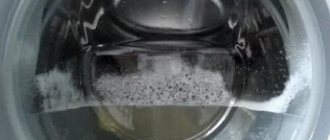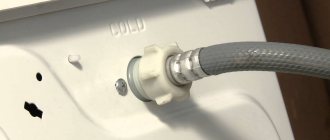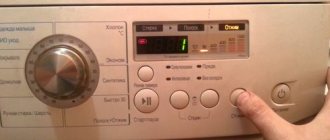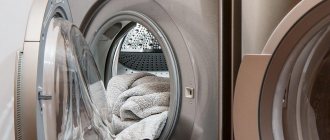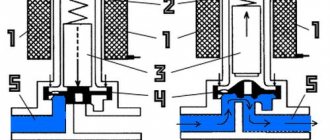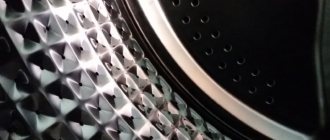If you have a washing machine, most likely you have long appreciated all its benefits. Modern housewives have long forgotten what it means to wash, rinse and spin clothes by hand.
Nevertheless, even the best and high-quality washing machine is still a piece of equipment that tends to break. Quite often a situation arises when the washing machine suddenly stops during the washing process and does not rinse or spin the laundry. Why does this happen and how to eliminate the problem? Let's look at the most common reasons.
The washing machine does not rinse well: reasons
Difficulties with rinsing things can only be discovered after the end of the washing program. A malfunction is indicated by white streaks on the laundry after removing it from the drum. Experts note popular reasons why a household washing machine does not rinse at all.
Overloaded
The permissible number of kilograms of laundry for loading is indicated on the device body. If you put more clothes in the drum, the washing powder gets stuck in the folds. Water practically cannot reach the clothes, so the product remains on the fibers.
Lots of washing powder
Why does a working washing machine perform poorly and poorly rinse your laundry? The reason is too much powder. The volume of water is simply not enough for copious amounts of household chemicals. Set the equipment to rinse again.
Hose is clogged
Waste water contains small debris - lint, dust, dirt, threads, small objects. To eliminate blockages in the drain pump, the liquid is filtered. When the filter is dirty, water is not allowed to pass through. There may be a large blockage in the pipe or pump.
Insufficient water pressure
Low water pressure occurs for two reasons:
- low pressure in the water supply system itself;
- clogged filter or water intake pipe.
In case of failures in the pumping station, the breakdown is temporary; the unit will operate normally after the pressure has stabilized. In the second case, hoses or strainers are cleaned.
Problem with water drainage
After washing, the liquid with residual powder fractions remains in the machine. The granules, mixed with clean water, penetrate the threads of the material. Drainage is disrupted when the pump is bent, clogged, or ruptured.
The heating element has failed
Control board malfunctions
The control module is responsible for executing all programs. In case of failures, the command for rinsing and spinning is not received. Only a technician can determine that it is the board that is broken.
Pressostat breakdowns
The water level sensor monitors the amount of water in the drum. The data is sent to the control board, from which the command for draining, rinsing and spinning is received. Element malfunctions lead to a complete stop of the washing process.
Causes
Let's consider the sources of lack of spin:
- the program options are set incorrectly;
- exceeding the permissible weight of the laundry;
- imbalance in the drum;
- the drive belt is stretched;
- the drain pump is faulty;
- the pressure switch has failed;
- tachometer is broken;
- short circuit in the motor winding;
- the brushes are worn out;
- failure of the electronic control module.
Let's look at each reason in more detail.
The washing machine doesn’t wash things well: what happened?
Why does an automatic washing machine wash clothes and bedding very poorly? Residual stains and poor rinsing of powder occur for several reasons.
Low-quality household chemicals
Cheap washing powder does not remove stains and stains from fabric. Replace it with a quality product, but follow the dosage. If the quantity is small, the clothes are not washed, but if the quantity is larger, white spots remain.
Water problems
When an automatic washing machine does not rinse bedding and clothes well for no reason, pay attention to the water. When using hard water, rust build-up on pipes, or lack of a dirt filter, stains are not removed.
Important! Powder products dissolve poorly in hard water and hardly foam, so the use of softeners is allowed.
Pollution
Clogged washing machines lead to the appearance of dark spots or rusty marks on clothes. Sources of pollution are:
- detachment of deposits from the heater;
- pieces of mold from the walls of the tank and the seal.
Advice! To prevent mold, dry the tank after washing by opening the door.
Equipment breakdowns
Difficulties in removing contaminants arise as a result of:
Useful tips
To extend the operating life of your washing machine, you must follow all the preventative tips recommended by the manufacturer. Remember that in your home only you can create the proper conditions for the normal operation of the washing machine.
Before you start using household appliances, they should be properly connected to all communication lines. Having completed the work, the unit is disconnected from the power supply and the cold water supply tap is turned off.
It is necessary to use only those detergents that are intended for use in automatic machines.
You will have to monitor the accumulation of scale and other deposits in the tank and on other components of the machine, and carry out preventive measures to remove them using special means.
Before loading the washing machine drum with laundry, you should check how securely the accessories are secured in your clothes and check the contents of the pockets.
The washing machine does not go into rinse mode: what to do
When your household washing machine does not switch to normal rinse mode at all, you can try to fix the problem yourself. You will need:
- Restart the washer by resetting the settings. After selecting the drain mode, the machine should start rinsing things;
- Check the drain pipe for kinks or damage. When an automatic washing machine spins and rinses poorly, the reason is a clogged hose or drain. Garbage must be removed;
- Inspect the filter for clogging and clean it. If a part is worn out, it is replaced;
Drive belt stretched
On a new car this is unlikely. But if your washer is more than 7 years old, the belt may stretch. This problem will resolve itself. To do this, remove the back cover and try to twist the belt along the axis. If more than 3 revolutions can be completed, replacement is necessary.
A stretched belt washes clothes without any problems, but slips in the spin mode - there is not enough traction with the drum pulley or the motor shaft.
Drive belt
Features of rinsing problems in different brands
Depending on the manufacturer of the equipment, rinsing failures manifest themselves in various ways:
- Indesit devices do not rinse or wring out laundry, but washing continues without failure. The motor rotates the drum in reverse, but the program itself is extended by several minutes. At the end of the cycle, soap stains remain on things, water does not drain well from the tank;
- Bosch machines do not wring out laundry or remove waste water due to clogged drains or pump malfunctions. The door remains closed at the end of the wash. To remove things, turn off the equipment and wait 5-10 minutes;
- LG brand laundry does not rinse due to heater combustion. The program continues without stopping, the time on the timer does not change;
- Front-loading models from all brands. Washing and rinsing are not carried out due to the drum not rotating. The mechanism only malfunctions when there is excessive load.
Filter element or hose
If the machine has not started rinsing and is stuck full of water, you will first have to empty the washer. The liquid is drained through the garbage filter - at the same time this element is checked for blockages. You should proceed like this:
- unplug the machine's power cord from the outlet;
- close the tap on the water pipe;
- unhook the lower false panel or open the technical hatch (depending on the SMA model, the garbage filter is “hidden” behind one of these elements);
- place unnecessary rags around the machine;
- place a container under the bottom of the machine in the “trash bin” area to collect water;
- Unscrew the filter plug half a turn;
- collect the soapy liquid in a basin.
When the tank is empty, the door lock will unlock - then you can remove things from the drum. Next, rinse the garbage filter in warm water and shine a flashlight into the hole where it was inserted. If there is debris inside, remove it.
The garbage filter should be cleaned once every 1-2 months.
It is also necessary to feel the entire length of the drain hose, it is likely that debris has accumulated there. Having found the “lump”, clean the sleeve with a long wire bent at the end. Additionally, the corrugation is washed under the tap.
Prevention of rinsing violations
- Before storing clothes, check your pockets and remove even small fluff from them;
- Use high-quality household chemicals and water hardness control products;
- Regularly inspect filters and pumps for blockages;
- Periodically wash the machine with special products or citric acid at 90 degrees;
- When connected, switch the equipment to a separate circuit breaker;
- Load the machine slightly less than the limit specified by the manufacturer - the drum should be 1/3 free;
- Periodically use the extra rinse option;
- Check the serviceability of the heating element by touching the door glass 30 minutes after start;
- Use only powders intended for automatic washing.
Modern automatic washing machines have completely relieved housewives of such rather labor-intensive and exhausting processes as washing, rinsing, spinning, and some models even dry clothes themselves. But sometimes even such practically perfect technology malfunctions, causing the quality of washing to sharply decrease. One of the most common problems that users complain about is that the washing machine does not rinse clothes well.
How to fix an Indesit machine yourself
Next we will talk about repairing the Indesit washing machine with our own hands. We will give advice with photos and videos, and step by step consider all the work that you can do without the help of a specialist.
Checking and replacing the heating element
It doesn't take much effort to detect problems associated with a burnt-out heater. Problems with the heater can be identified by a number of signs:
- In the vast majority of cases, the Indesit machine itself informs the owner about the breakdown of the heating element. Error F07 is displayed on the screen, or the 1st, 2nd and 3rd indicators are flashing.
- Indirect signs will also indicate its breakdown. So, the powder may not dissolve during washing because the water is not heated. 20 minutes after starting the program, touch the hatch: if it is cold, it means the heating element is not working.
To find, check and remove the heating element, proceed as follows:
- Take a suitable screwdriver and unscrew the back panel, which is usually secured with four bolts.
- At the bottom of the tank you will see 2 contacts protruding from its wall. This is the heater shank - the heating element itself is located under the drum. Remove the wiring from the heater and the sensor (located inside the heater).
- Take a tester and take measurements - place the probes against the contacts. If the device shows a value in the region of 20-40 Ohms, then the heater is in order. If the value is 0, then the heating element is closed, and 1 or ∞ indicates a break in the heater.
- At the same time, check whether the heating element is breaking through to the housing. To do this, turn on the buzzer mode on the tester. Place the probes like this: one to the contact, the other to the body. If everything is in order, then the tester works quietly, if there is a breakdown, it will beep.
- Next, remove the old heating element, even if the tester readings are normal. To do this, unscrew the central fastener by unscrewing the nut. Take out the seal.
- Inspect the heating element. If there is a thick layer of scale or dark spots on it, then the element 100% needs to be replaced.
Important! Buy a new heating element together with a rubber seal to tightly install and secure the heater.
- Before installing the heating element, clean the place in which it is attached from scale and debris. If this is difficult to do by hand, use a wire hook or bottle brush.
- Install a new heating element, connect the wires and assemble the machine.
Replacing the surge protector
Malfunctions of Indesit washing machines and their elimination are a problem for many users, especially due to manufacturing defects. But if the filter is not defective, it means that it was “finished off” by unfavorable operating conditions - high humidity in the room or constant power surges in the network.
While people are thinking about how to protect the filter from unstable voltage in our homes, we will tell you how to carry out the repair yourself. Proceed as follows:
- Remove the top cover by unscrewing the bolts that secure it.
- The filter is located on the back of the power cord, like a plug - only inside the machine.
- Once you have found the filter, unscrew the screw that holds it in place.
- The part cannot be repaired. You need to replace the element by purchasing an original part.
From user experience:
The owner of SM Indesit came to the workshop, already desperate to change anything: according to him, he had already changed the filter 3 times. His working capacity was enough for 5 months at most. The technician examined the machine and said that the filter was burning out due to high humidity. He installed a new part, and treated the contacts going to it with silicone sealant. The lucky owner has been using the machine for the second year.
Important! If you decide to follow this experience, dry, clean and wipe them before applying sealant to the contacts.
How does the rinsing problem manifest itself?
It is possible to detect such a malfunction in the operation of the washing machine only after the completion of the washing cycle. If, after taking the laundry out of the drum, you find that there are white streaks left on it, this is a signal that the unit is not rinsing the powder out of the fabric fibers well.
The machine does not rinse well
And this, as we know, can lead to skin irritation and allergies. To fix the problem with rinsing, you first need to find out what is causing the problem with your machine.
Brushes are worn out
Expert opinion
I work in the household appliance repair industry. Extensive experience in restoring washing machines and dishwashers.
Ask a Question
In fact, wear of the motor brushes is not a malfunction, since they wear down at a certain level and must be replaced. An air gap appears at the contact point, and the engine stops rotating. With average use of the Indesit washing machine, corresponding to 2-3 washes per week, replacement is needed after 10-12 years. That is, brushes are consumables.
Wear can only be determined visually. The job requires some skills. It is better to entrust it to a specialist. Master class on replacing brushes.
brush assembly assembly
Why does my washing machine rinse clothes poorly?
Once again, while washing your clothes, you suddenly discover that the rinsing is not being done properly. Why is this happening?
Failure of the heating element
The reason why the automatic machine does not completely rinse the detergent from the clothes may be one of the following:
- The washing machine is overloaded. If more laundry was placed in the drum than stated by the manufacturer, the washing powder will clog into the folds of the clothes and remain on it, since practically no water gets into them.
- There was more powder than needed. In this case, the powder is poorly rinsed because the volume of rinsing water prescribed in the program is too small for the volume of detergent that has entered the drum.
- Insufficient water pressure. First, you need to understand what the reason is: either this low water pressure is associated with manipulations at the pumping station, or the problem is directly with the water supply hose going to the machine (the filter or the hose itself is clogged). In the first case, the remaining powder on the laundry is a temporary inconvenience that will go away on its own after the pressure in the water supply normalizes; the second requires cleaning the hose or filter mesh.
- Problem with water drainage. In this case, the waste water, which still contains powder, does not completely pour out of the washing machine drum. These residues are mixed with the clean water added for rinsing and, accordingly, again pass through the fibers of the fabric. The reason for this may be a clogged drain filter, a broken drain pump, or a kinked or clogged drain hose.
- The heating element has failed. Over time, the heating element becomes covered with scale and rust due to hard water. Then the washing machine stops heating the water normally, and the detergent does not dissolve completely.
The problem is not with the machine
When the machine does not switch from wash to rinse, it freezes in the middle of the cycle, with a full tank of water. It is impossible to ignore such a problem. You will have to diagnose the machine and check its main components for serviceability. Of course, it’s easier to pay and entrust the repair to service center specialists, but you can fix the problem yourself. Let's figure out what to do first.
Before diagnosing, experts recommend making sure that nothing is obstructing the draining of water outside the machine. Therefore, the drainage hose is inspected first. Check to see if the sleeve is kinked. Perhaps it got under the foot of the washer and is now crushed, so the water does not leave the tank. If everything is in order with the corrugation, check the sewer.
Sometimes the reason that liquid is not removed from the washing machine is a blockage in the common house riser or siphon. If the water flows poorly from both the bathtub and the washbasin, then you will have to clean the sewer pipe. It is better to invite a plumber for this work.
The automatic machine will not proceed to rinsing if the drainage system is clogged.
If no external factors prevent the water from draining, then the cause must be looked for inside the washing machine. You will have to perform comprehensive diagnostics of the equipment, checking each component, the failure of which could cause a freeze. We will provide detailed instructions on what to do next.
What to do if the machine does not rinse clothes well when washing
To avoid future problems with the machine not rinsing your clothes well enough, you must follow these rules:
- Do not overload the washing machine with laundry.
- Do not add more powder than the recommended amount. As the amount of clothes washed decreases, the amount of detergent used also decreases.
- When the machine begins to fill with water, check to see if all the powder has been washed out of the container. This way you can determine whether the water pressure in the tap is sufficient.
- To check the serviceability of the heating element, 20-30 minutes after the start of the wash cycle, you can touch the hatch and determine approximately whether the required temperature conditions are being maintained during rinsing.
- Use the Extra Rinse or Aqua Plus function on your machine. After completing the wash cycle, you can also rinse the laundry again using a separate “Rinse” program.
- Use fabric softeners and other fabric softeners correctly.
Checking the water supply valve
How can I avoid problems with switching washing modes in the future?
To prevent the washing machine from starting to switch modes poorly again after the replacement, you must adhere to the following operating rules:
- When washing with hard water, be sure to use products that reduce its hardness. If this is not done, scale will form, and it will gradually destroy the heating element.
- For each type of thing you need to select the appropriate mode.
- Before placing items in the drum, they must be sorted by the material from which the fabric is made. However, you should not exceed the permissible weight.
- Use only reliable detergents.
- Approximately once every 3-4 months it is necessary to clean the heating element from oxidation using regular citric acid or specialized products. This way you can significantly extend the life cycle of the heater.
When you need to call a specialist
Some washing machine breakdowns simply cannot be fixed on your own. If the unit rinses clothes poorly and you don’t understand why, this may mean that it requires serious repairs.
If, after carrying out all the manipulations described above, the machine still does not rinse the clothes, you need to call a specialist to your home or take it to a service center.
The technician will figure out what the problem is, why this happened, and will be able to fix the problem.
What serious problems can interfere with high-quality rinsing:
- The water level sensor is broken. In this case, the rinse water intake mode is not observed and the sensor will need to be replaced.
- Control board malfunction. Because of this, the machine does not receive the commands specified in the washing program, and its execution stops. In this case, the control board needs to be reflashed or replaced with a new one.
But cases of serious breakdowns requiring specialist intervention are rare. By following simple rules for caring for your automatic machine and avoiding contamination of the elements, you can keep it in excellent working condition for a long time.
If you have a washing machine, most likely you have long appreciated all its benefits. Modern housewives have long forgotten what it means to wash, rinse and spin clothes by hand.
Nevertheless, even the best and high-quality washing machine is still a piece of equipment that tends to break. Quite often a situation arises when the washing machine suddenly stops during the washing process and does not rinse or spin the laundry. Why does this happen and how to eliminate the problem? Let's look at the most common reasons.
Call the master
If you cannot repair your washing machine on your own, you need to seek help from a specialist.
There are several ways to find a master:
- Contact the service center.
- Find an advertisement in the newspaper.
- View advertisements on the Internet on specialized websites.
- Take advantage of word of mouth.
To avoid dealing with a scammer, you need to study in advance the approximate prices for different types of repairs:
cleaning the blockage, replacing the water supply valve - from 600 rubles;- repair of the pressure switch – 1500 rubles;
- replacement of brushes – from 1400 rubles;
- removal of a foreign object between the tank and the drum - from 600 rubles;
- pump replacement – from 1500 rubles;
- repair of the control board – from 2400 rubles;
- replacement of the balance sensor – from 900 rubles.
The price does not include the price of the part. If repairs of spare parts are required, they are paid separately. An honest master will warn you in advance about how much his services will cost, so that the final payment does not become an unpleasant surprise for the client.
You need to ask the repairman in advance whether he gives a guarantee for the work performed. It must be documented.
A lot of important and useful information about repairing Indesit washing machines is presented in this section.
The washing machine does not rinse clothes well
If the washing machine does not rinse the laundry or does it poorly, there may be several reasons for this, from the simplest and most banal to the complex and unpleasant. Here are a few situations when the reason does not lie in the breakdown of the unit:
Overload. If you load too much laundry into the machine, there is not enough space for the washing powder and it does not dissolve well. It gets caught in the folds of clothes and does not have enough contact with water.
A large amount of powder. Sometimes white streaks remain on laundry because the amount of powder much exceeds the volume of water provided for rinsing. To eliminate the problem, just run an additional cycle several times.
Low water pressure. Insufficient pressure occurs for two reasons:
- problems with the entire water supply system;
- The hose supplying water to the unit is clogged.
In the first case, you cannot do anything, you just need to wait until the situation improves. In the second, you need to clean the supply pipe and the filter mesh installed at the entrance to the system, the rinsing program will work again.
If none of the above is confirmed, most likely the cause of the trouble lies in a breakdown of the washing machine itself.
The washing machine is frozen and does not go into rinse mode
The situation looks something like this: the washing machine starts in normal mode, washes for a while, but as soon as it comes to rinsing, the program for some reason stops and goes into standby mode. First you need to find out what exactly your assistant does not want to do: rinse, wring out or pump out water.
First of all, you need to reset the current settings, select the “drain” mode and start the washer again. If nothing happens, examine the integrity of the drain hose. It is likely that it was simply twisted or pinched by something heavy. Therefore, the washing machine does not spin out the laundry. Is the hose ok? Check to see if there is a blockage in the sewer pipe. To do this, carefully disconnect the drain pipe and lower it into the bathtub or sink. If the “drain” program works, then the problem is in the plumbing.
After all the manipulations done, everything remains the same and the washing machine does not rinse or spin the clothes? This means everything is bad - the problem is in the car.
When you can solve the problem yourself
The lack of mode switching in the SMA is not always associated with a breakdown. Here are the reasons that you can eliminate on your own.
- Incorrect installation of the washing machine. If the drain hose is lowered below the level of the tank, the water from the washing machine will go down the drain itself. In such a situation, the machine will have to constantly add water. As a result, the wash will take forever, and the machine will not finish rinsing. To fix the problem, install the machine according to the instructions yourself or call a washing machine installer.
- Drain filter clogged. Due to the blockage, the machine cannot drain the water, so it hangs with it at the wash or rinse stage and does not switch to the next stage. It is necessary to clean the drain filter for proper operation of the equipment. Instructions for cleaning the filter are in the instruction manual for your washing machine. Or you can use our article on how to clean your washing machine filter.
- The drain hose is pinched. In this case, the SMA cannot drain the water or drains it too slowly, causing it to freeze during the washing or rinsing phase. Inspect the drain hose along its entire length, straighten it for normal drainage of water.
- Blockage in the sewer. Often the washing machine drain is connected to the siphon of the sink in the bathroom or kitchen. It gets clogged over time. As a result, the machine cannot drain the water, freezes and does not switch to rinsing or spinning. It is necessary to clean the siphon: yourself or by calling a plumber.
- Overloading the washing machine . If you exceed the recommended weight of the laundry when loading the machine, it will not be able to evenly distribute the clothes in the spin drum, reach high speeds and spin the laundry. It is necessary to remove some of the laundry and start the spin cycle again.
- Imbalance when laying out laundry. If the laundry is gathered in one lump (for example, in a duvet cover) or you are washing a large item (bedspread, blanket), the machine cannot distribute the items evenly across the drum and stops without switching to spinning. It is necessary to manually distribute things into the drum.
- One-time failure of the control unit. Sometimes the control modules of washing machines freeze. In this case, you need to reboot: to do this, disconnect the SMA from the power supply for 10-15 minutes. If the reason was a one-time failure, after turning on the machine will begin to work correctly.
The washing machine does not rinse or spin
Before you start troubleshooting, you need to turn off the power to the machine. Be sure to remove the plug from the outlet, this is very important! Now you need to forcefully empty the unit of water. This can be done through the drain filter. It is located at the bottom of the machine, behind a small panel. Now take out the laundry, you will have to rinse and wring it by hand. Everything is ready, let's start troubleshooting.
Blockage in the pump, drain filter or pipe
This is the most common answer to the question why the washing machine does not go into rinse mode or does not spin clothes well. There is a lot of debris left in the dirty water that the machine drains after washing. Sand, dust, dirt, hair, threads and small pellets and fluff. Sometimes the contents of the pockets are added to all this. Garbage clogs the drainage system and the water simply has nowhere to go. In order for rinsing to resume, you need to thoroughly clean the drain and fill filter.
Broken water level sensor
There is such a device in the washing machine - a pressure switch. It determines the water level in the unit tank. Depending on the data received from this device, the control board commands the washing process. If the water level sensor is broken, the washing machine simply “does not understand” what to do and stops.
The drain pump has become unusable
This is another reason why the rinse mode does not work, or the washing machine does not spin out things. The drain pump does not pump out water after washing and the washing machine does not rinse the clothes. The cause of the breakdown may be various objects getting into the drain pump or simply a long period of operation.
If all the hoses, filters and tubes are cleaned, the drain works as expected, and still the washing machine does not switch the rinse mode, you can find a couple more reasons for this.
The heating element burned out
If the heating element burns out, the water simply does not heat up to the set temperature. This causes the process to stop at the washing stage, and the rinsing mode simply does not have time to start. If, when setting the washing mode, you set the temperature to more than 30˚C, just touch the glass. Is it completely cold? This means that the heating element is faulty and needs to be replaced.
Control module burned out
In other words, the control board in the washing machine has become unusable. Without this part, the machine stops receiving and receiving commands, which means the rinsing mode will not turn on.
The pump may be broken
Usually the pump does not break down suddenly; the machine begins to show signs of a problem in advance. If you noticed that previous cycles lasted longer than usual, and the pumping of water was accompanied by a strong hum, then the pump is most likely the culprit for the freeze. If you do not respond to such symptoms, after a while the node will fail.
The drain pump may stop working due to:
- blockage - in this case, the movement of the impeller is blocked by debris;
- breakdowns.
You can solve problems with your pump yourself. To get to the element, you need to lay the automatic machine on its left side. If there is no bottom, good - access to the pump will be immediate. When there is a tray, disconnect it from the body.
Next, you need to unhook the pump from the snail and carefully inspect it. If there is a lot of debris or a foreign object stuck between the impeller blades, clean them. When there are no visual defects, the part is checked with a multimeter. A burnt out drain pump cannot be repaired and will need to be replaced.
Applying ohmmeter probes to the pump contacts, evaluate the readings on the device screen. Zero or one will indicate the need to replace the pump. If the problem is in the control module, the tester will show a three-digit number.
Some tips
If you want your washing machine to always please you with clean and fresh laundry, and the rinse mode to always turn on and work perfectly, follow these simple rules:
- use only high-quality detergents; cheap powders do not dissolve well in water;
- load the machine a little less than required according to the instructions, leave more free space;
- carefully check pockets and cuffs before washing, be sure to remove dirt and foreign objects;
- half an hour after the start of the washing process, touch the glass, make sure that the water in the machine has heated up to the desired temperature;
- use the “extra rinse” function without using rinse aid;
- At least once every six months, do preventative cleaning of the water intake and drainage systems, and also check the filters.
If you follow these simple rules, your home assistant will delight you with uninterrupted work for a long time.
What to do first?
If a properly working Indesit machine suddenly starts to freeze while performing operations, there is no need to panic. Sometimes the slowdown in the operation of the device is not associated with a breakdown.
If a problem is detected, the priority actions should be as follows:
- Rebooting equipment . To do this, you need to hold the “Start” button for a few seconds. The running program must stop. If you cannot reset it, you must move the programmer knob to the neutral position and hold the “Stop/Start” button for 5 seconds. Then unplug the cord from the outlet and leave the device turned off for 15 minutes, then turn it on again.
- Check to see if the laundry is bunched up . If there is a serious imbalance, the machine may stop. If this really happens, you need to lay out the laundry manually, or divide it into 2 parts and spin them alternately.
- Check the specified program . There are options that do not involve spinning and draining water from the tank. In this case, they must be turned on forcibly.
If none of these problems were found, you need to look for other reasons for the washing machine freezing.
